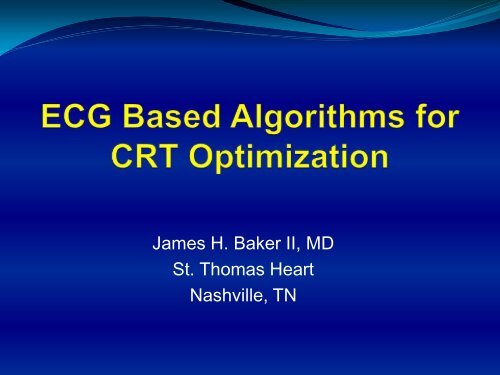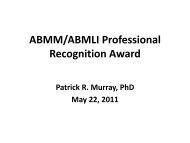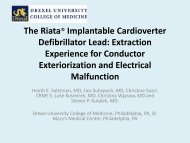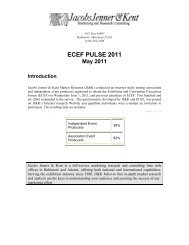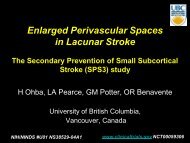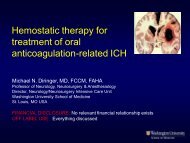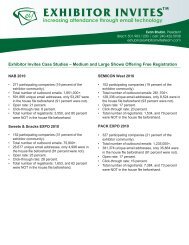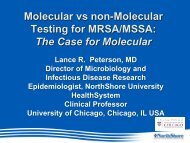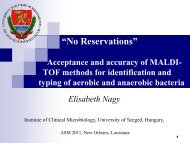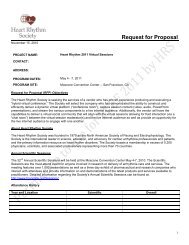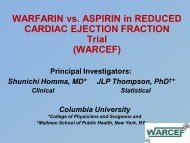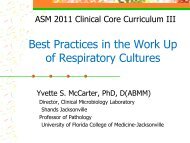ECG Based Algorithms for CRT Optimization
ECG Based Algorithms for CRT Optimization
ECG Based Algorithms for CRT Optimization
Create successful ePaper yourself
Turn your PDF publications into a flip-book with our unique Google optimized e-Paper software.
James H. Baker II, MD<br />
St. Thomas Heart<br />
Nashville, TN
Overview<br />
Non-responder rate with <strong>CRT</strong> remains 30-35%<br />
despite mature technology<br />
MIRACLE study (ACC 2001): 67% improved HF CCS
Overview<br />
Non-responder rate with <strong>CRT</strong> remains 30-35%<br />
despite mature technology<br />
MIRACLE study (ACC 2001): 67% improved HF CCS<br />
FREEDOM study (HRS 2010): 67.5%
Overview<br />
Non-responder rate with <strong>CRT</strong> remains 30-35%<br />
despite mature technology<br />
MIRACLE study (ACC 2001): 67% improved HF CCS<br />
FREEDOM study (HRS 2010): 67.5%<br />
Primary options <strong>for</strong> improving response rate include<br />
better patient selection, improved LV lead<br />
positioning, and optimization of timing intervals
<strong>Optimization</strong> of <strong>CRT</strong><br />
Programming<br />
Timing interval optimization part of most multicenter<br />
<strong>CRT</strong> trials, although techniques used were varied<br />
Echocardiographic method<br />
Supported by American Society of Echocardiography
<strong>Optimization</strong> of <strong>CRT</strong><br />
Programming<br />
Timing interval optimization part of most multicenter<br />
<strong>CRT</strong> trials, although techniques used were varied<br />
Echocardiographic method<br />
Supported by American Society of Echocardiography<br />
Acute hemodynamic and short-term clinical improvement<br />
documented in numerous small studies
<strong>Optimization</strong> of <strong>CRT</strong><br />
Programming<br />
Timing interval optimization part of most multicenter<br />
<strong>CRT</strong> trials, although techniques used were varied<br />
Echocardiographic method<br />
Supported by American Society of Echocardiography<br />
Acute hemodynamic and short-term clinical improvement<br />
documented in numerous small studies<br />
Limited by cost, complexity, time demands
<strong>Optimization</strong> of <strong>CRT</strong><br />
Programming<br />
Timing interval optimization part of most multicenter<br />
<strong>CRT</strong> trials, although techniques used were varied<br />
Echocardiographic method<br />
Supported by American Society of Echocardiography<br />
Acute hemodynamic and short-term clinical improvement<br />
documented in numerous small studies<br />
Limited by cost, complexity, time demands<br />
Nominal settings standard of care<br />
ACT Registry of >1000 <strong>CRT</strong>-D patients found < 10%<br />
received optimization of timing intervals (2006)
Intracardiac Electrogram (IEGM)<br />
Methods <strong>for</strong> <strong>CRT</strong> <strong>Optimization</strong><br />
Review available techniques<br />
AV optimization<br />
VV optimization<br />
Discuss clinical studies<br />
Future applications
AV <strong>Optimization</strong><br />
Goal – maximize LV preload by allowing <strong>for</strong> the<br />
completion of the atrial contribution to diastolic filling<br />
be<strong>for</strong>e mitral valve closure<br />
Barold S S et al. Europace 2008;10:iii88-iii95
QuickOpt TM Method of AV <strong>Optimization</strong><br />
Empirical method based on clinical observations and<br />
validated by echocardiographic studies<br />
Algorithm makes optimized AV delay calculations<br />
based on the duration of the intrinsic atrial IEGM<br />
Aims to ensure that ventricular pacing occurs after<br />
atrial depolarization and mechanical contraction are<br />
complete
AV <strong>Optimization</strong> - QuickOpt TM<br />
Offset factor: 30 ms if AV > 100<br />
60 ms if AV < 100
AV <strong>Optimization</strong> - SmartDelay TM<br />
Developed through intraoperative measurements<br />
and validated with invasively measured LV dP/dT<br />
Uses intrinsic AV intervals and the duration of native<br />
VV conduction time to calculate the optimal delay<br />
Adjusted <strong>for</strong> LV lead location<br />
Separate calculations <strong>for</strong> sensed and paced AV delays<br />
Truncates the AV delay to between 50 ms and 70% of<br />
the intrinsic AV interval
Optimal Balance of Intrinsic and Paced Wavefronts<br />
Better with more<br />
prolonged QRS<br />
interval
VV <strong>Optimization</strong> - QuickOpt TM<br />
Aims to ensure the paced LV and RV conduction<br />
wave fronts meet in the septum and coordinate LV<br />
and RV contraction to maximize resynchronization<br />
Measures both sensed and paced conduction delays<br />
between the LV and RV leads to calculate the<br />
optimal VV interval<br />
Correlates well with aortic VTI and 3D echo<br />
techniques
Long-term Clinical Studies of<br />
IEGM-<strong>Based</strong> <strong>Optimization</strong><br />
FREEDOM study - investigated effect of frequent<br />
optimization of AV and VV intervals using QuickOpt<br />
on outcome of <strong>CRT</strong> in comparison to usual care<br />
SMART-AV trial – compared the results of <strong>CRT</strong><br />
using 3 different techniques <strong>for</strong> programming AV<br />
delays: fixed delay of 120 ms, echo-optimized delay<br />
and AV delay optimized with SmartDelay<br />
Adaptive <strong>CRT</strong> study – Medtronic, results pending
Baseline Evaluation<br />
To document inclusion / exclusion criteria and establish baseline<br />
heart status*<br />
Randomization (1:1:1 SmartDelay: Echo: Fixed)<br />
1 – 14 days post implant<br />
Clinic Follow-up Visits<br />
3 month and 6 months post implant<br />
SMART-AV Trial<br />
Compared the effects of 3 techniques <strong>for</strong> AV delay programming <strong>for</strong> <strong>CRT</strong><br />
AV Delay Optimized<br />
Quarterly Using<br />
SmartDelay<br />
AV Delay Optimized<br />
Using Echo<br />
(Iterative Method)<br />
AV Delay Fixed at<br />
120ms with 0 Offset
SMART-AV Results – 6 month data*<br />
Ellenbogen et al Circulation 2010; 122:2260-2668<br />
The change in LVESV <strong>for</strong><br />
the SmartDelay arm was<br />
no different than echodetermined<br />
AV delay or<br />
fixed delay of 120 mg
SMART-AV Results – 6 month data*<br />
Ellenbogen et al Circulation 2010; 122:2260-2668<br />
The change in LVESV <strong>for</strong><br />
the SmartDelay arm was<br />
no different than echodetermined<br />
AV delay or<br />
fixed delay of 120 mg<br />
“The routine use of AV<br />
optimization techniques<br />
assessed in this trial is<br />
not warranted”
Future of EGM-<strong>Based</strong> <strong>Algorithms</strong><br />
Potential role in non-responders<br />
RESPONSE-HF trial (HRS 2010)<br />
Non-responders after 3 months of simultaneous VV<br />
pacing randomized to sequential vs. simultaneous<br />
pacing (primarily using QuickOpt)<br />
Higher percentage converted to responders with VV<br />
optimization: 76.9% vs. 48.4%
Future of EGM-<strong>Based</strong> <strong>Algorithms</strong><br />
Potential role in non-responders<br />
RESPONSE-HF trial (HRS 2010)<br />
Non-responders after 3 months of simultaneous VV<br />
pacing randomized to sequential vs. simultaneous<br />
pacing (primarily using QuickOpt)<br />
Higher percentage converted to responders with VV<br />
optimization: 76.9% vs. 48.4%<br />
SMART-AV substudy – QLV<br />
Subset of <strong>CRT</strong> patients may benefit from SmartDelay
LVESV Response: SmartDelay vs. Fixed<br />
Multivariate Logistic Regression Results<br />
The LVESV response rate <strong>for</strong> SD vs. fixed increased as QLV prolonged. In the highest quartile of<br />
QLV, SD had a greater than 6 fold increase in odds ratio <strong>for</strong> a LVESV response vs. fixed.<br />
Gold MR et al. HRS 2012<br />
Adjusted <strong>for</strong> baseline EF, LVESV, Etiology of HF, LBBB, Gender, NYHA, QRS and age


